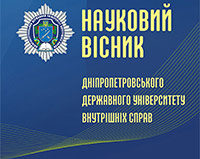Andrii HREBENIUK, Alina LUKOMSKA
HREBENIUK A., LUKOMSKA A. (2022), INNOVATIONS IN CRIMINAL SCIENCES: PROSPECTS OF USING INNOVATIVE TECHNOLOGIES REGARDING THE BRAINS OF THE DEAD TO SOLVE CRIMES; Scientific Bulletin of Dnipropetrovsk State University of Internal Affair, Special Issue №2, 366-373
DOI: 10.31733/2078-3566-2022-6-366-373
ABSTRACT. In the article, for the first time in the history of forensics, the issue of using the latest technologies to transfer information that is in the memory of the deceased (victim, eyewitness) by digitizing the brain and transferring the corresponding information in digital form to a disk, where it will be stored until the use of computer programs for the analysis of digitized brain slices for detailed reproduction of the situation and further clarification of the circumstances with the aim of solving the crime, and therefore finding and punishing the culprit. We conducted an analysis of modern experiments and research, the opinions of scientists and innovative implementations in relation to the relevant issues.
Keywords: innovative technologies, brain, memory, consciousness, computer system.
- References:
- Zavantazhennia svidomosti [Loading consciousness]. Vikipediia. URL : https://uk.m.wikipedia.org/wiki/%D0%97%D0%B0%D0%B2%D0%B0%D0%BD%D1%82%D0%B0% D0%B6%D0%B5%D0%BD%D0%BD%D1%8F_%D1%81%D0%B2%D1%96%D0%B4%D0%BE%D0 %BC%D0%BE%D1%81%D1%82%D1%96 [in Ukr.].
- Holovnyi mozok liudyny [Human brain]. Vikipediia. URL : https://uk.m.wikipedia.org/wiki/%D0%93%D0%BE%D0%BB%D0%BE%D0%B2%D0%BD%D0%B8 %D0%B9_%D0%BC%D0%BE%D0%B7%D0%BE%D0%BA_%D0%BB%D1%8E%D0%B4%D0%B8 %D0%BD%D0%B8 [in Ukr.].
- Koch, Christof; Tononi, Giulio (2008). Can machines be conscious?. IEEE Spectrum 45 (6): 55. URL: https://www.researchgate.net/publication/3000899_Can_machines_be_conscious
- «Zakon Mura» [“Moore’s Law”]. Vikipediia. URL : https://ru.m.wikipedia.org/wiki/ %D0%97%D0%B0%D0%BA%D0%BE%D0%BD_%D0%9C%D1%83%D1%80%D0%B0 [in Ukr.].
- Alexis Bédécarrats, Shanping Chen, Kaycey Pearce, Diancai Cai and David L. Glanzman «RNA from Trained Aplysia Can Induce an Epigenetic Engram for Long-Term Sensitization in Untrained Aplysia». Neuro 14 May 2018, 5 (3) ENEURO.0038-18.2018. URL : https://doi.org/10.1523/ENEURO.0038-18.2018.
- Blue Brain Project. Reconstruction and Simulation of Neocortical Microcircuitry. URL : https://www.cell.com/cell/fulltext/S0092-8674(15)01191-
5?_returnURL=https%3A%2F%2Flinkinghub.elsevier.com%2Fretrieve%2Fpii%2FS0092867415011915 %3Fshowall%3Dtrue#%20. - Human Brain Project. Welcome to the Human Brain Project. URL : https://www.humanbrainproject.eu/en/.
- Skilky Bitiv Danykh Znadobytsia, Shchob Predstavyty Vse Zhyttia Yak Film [How Many Bits of Data Would It Take to Present All of Life as a Movie]? Vita Aidelos. URL: https://uk.vita aidelos.com/3501-how-many-bits-of-data-would-it-take-to-represent-an-e.html. [in Ukr.].
- Kuzmenko, V. V. (2019) Psykholohiia deviantnoi povedinky [Psychology of deviant behavior] : navch. posibnyk. Dnipro : Vydavets Bila K.O., 68 p. URL : http://er.dduvs.in.ua/handle/123456789/3197. [in Ukr.].
- Advancing the Science and Technology of Memory. URL: https://nectome.com/.
